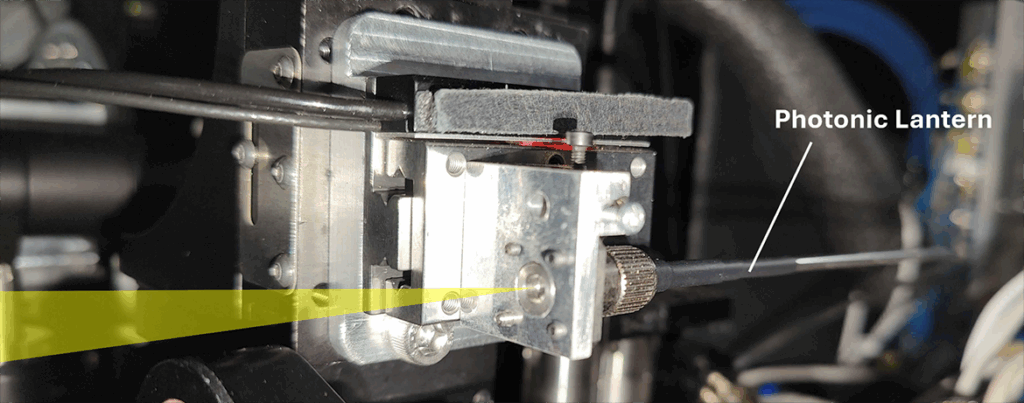
A groundbreaking imaging technique, utilized for the first time on a ground-based telescope, has enabled a UCLA-led team of astronomers to achieve the sharpest-ever measurement of a star’s surrounding disk. This innovation unveils previously unseen structures and paves the way for new astronomical discoveries. The findings, published in the Astrophysical Journal Letters, mark a significant advancement in the field of astronomy.
The ability to observe fine details of astronomical objects is largely dependent on the size of the telescope. As the viewing aperture of a telescope increases, it gathers more light, making fainter objects visible and producing sharper images. Traditionally, the sharpest images are obtained by linking multiple telescopes into arrays. However, this new method achieves high resolution using a single telescope, thanks to a device known as a photonic lantern.
Revolutionizing Telescope Imaging
The photonic lantern, a specially designed optical fiber, plays a crucial role in this breakthrough. It splits starlight according to its fluctuation patterns, preserving subtle details that are typically lost. By reassembling these measurements, astronomers can reconstruct high-resolution images of celestial objects, such as the disk around a nearby star.
“In astronomy, the sharpest image details are usually obtained by linking telescopes together. But we did it with a single telescope by feeding its light into a specially designed optical fiber, called a photonic lantern,” explained Yoo Jung Kim, the study’s first author and a UCLA doctoral candidate. “This device splits the starlight according to its patterns of fluctuation, keeping subtle details that are otherwise lost.”
Collaborative Efforts and Technological Innovation
The photonic lantern was designed and fabricated through a collaboration between the University of Sydney and the University of Central Florida. It is a key component of the new instrument FIRST-PL, developed and led by the Paris Observatory and the University of Hawaiʻi. This instrument is integrated into the Subaru Coronagraphic Extreme Adaptive Optics instrument at the Subaru Telescope in Hawaiʻi, operated by the National Astronomical Observatory of Japan.
“What excites me most is that this instrument blends cutting-edge photonics with the precision engineering done here in Hawaiʻi,” said Sebastien Vievard, a faculty member in the Space Science and Engineering Initiative at the University of Hawaiʻi. “It shows how collaboration across the world, and across disciplines, can literally change the way we see the cosmos.”
Overcoming Atmospheric Challenges
Initially, the application of this technique was challenged by atmospheric turbulence, which causes objects viewed through a telescope to fluctuate. To mitigate these effects, the team employed adaptive optics, which stabilize light waves in real time. Despite this, the photonic lantern’s sensitivity required the development of a new data processing technique to filter out remaining atmospheric disturbances.
“We need a very stable environment to measure and recover spatial information using this fiber,” noted Kim. “Even with adaptive optics, the photonic lantern was so sensitive to the wavefront fluctuations that I had to develop a new data processing technique to filter out the remaining atmospheric turbulence.”
Discovering New Cosmic Phenomena
The team used the photonic lantern-equipped Subaru Telescope to observe the star beta Canis Minoris (β CMi), located approximately 162 light-years from Earth in the constellation Canis Minor. The star’s surrounding disk, composed of hydrogen, rotates rapidly, causing a color shift due to the Doppler effect. This shift allowed the team to measure color-dependent image shifts with unprecedented precision, revealing an unexpected asymmetry in the disk.
“We were not expecting to detect an asymmetry like this, and it will be a task for the astrophysicists modeling these systems to explain its presence,” said Kim.
Implications for Future Discoveries
This novel imaging approach allows astronomers to view smaller and more distant objects than ever before, potentially unlocking answers to longstanding cosmic mysteries. The discovery of the lopsided disk around β CMi exemplifies the new questions that this technology can generate.
The international effort behind this breakthrough included researchers from various institutions, such as the Space Science and Engineering Initiative group at the University of Hawaiʻi, the National Astronomical Observatory of Japan, the California Institute of Technology, the University of Arizona, the Astrobiology Center in Japan, the Paris Observatory, the University of Central Florida, the University of Sydney, and the University of California Santa Cruz.
As Nemanja Jovanovic, a co-leader of the study at the California Institute of Technology, remarked, “This work demonstrates the potential of photonic technologies to enable new kinds of measurement in astronomy. We are just getting started. The possibilities are truly exciting.”







